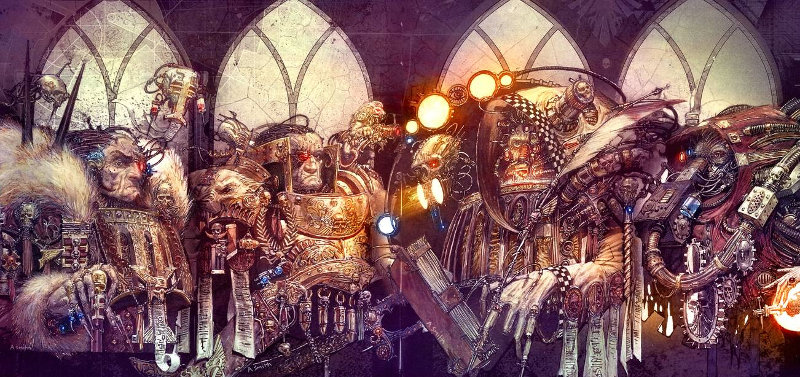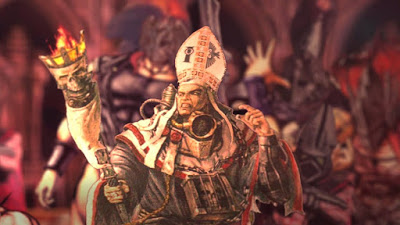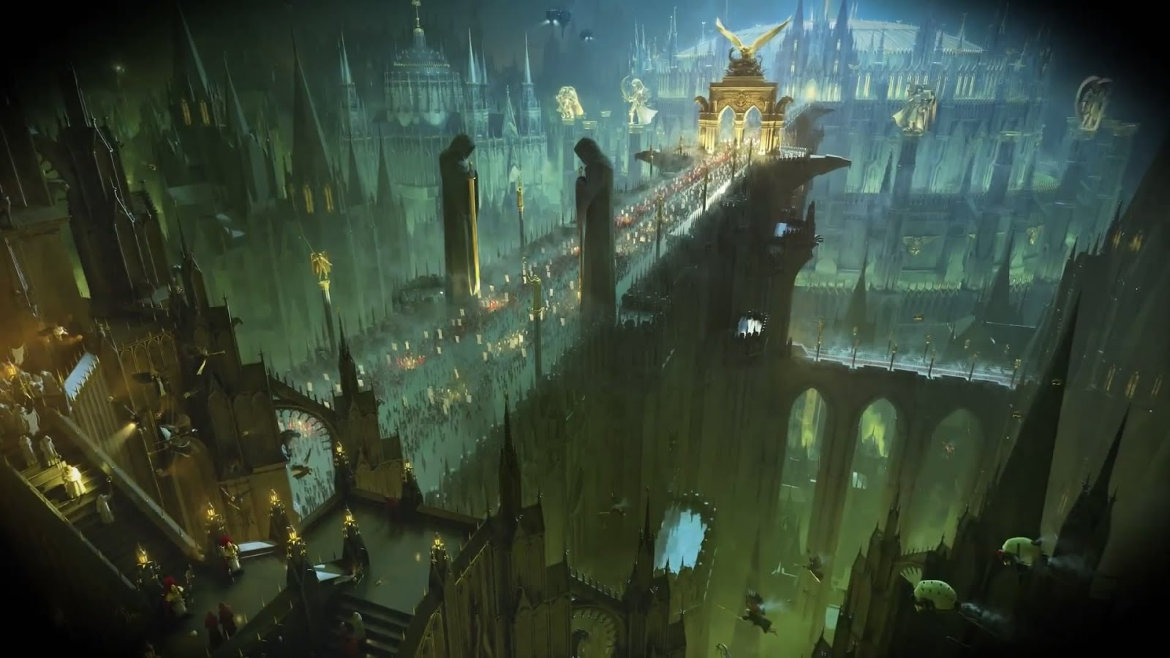Ophelia Dominant
In the millennia following the creation of the Via Imperator and the establishment of Ophelia VII as the first of the pilgrimage worlds, its power and influence within the Ecclesiarchy continued to grow, until the Cardinal of Ophelia was almost as powerful as the Ecclesiarch himself (and, in some instances, when a weak-willed man was appointed to the See of Terra or a particularly wily member of the Laertes dynasty received the Ophelian miter, even more so). The Temple of the Savior Emperor - now known as the Imperial Creed - had been made the state religion of the Imperium and deviation, heresy or apostasy was a capital crime. The power of the Ecclesiarchy over the wider Imperium was immense and even many of the High Lords of Terra would take their lead from the views of the Ecclesiarch, believing he was the mouthpiece for the will of the Emperor - a belief the Adeptus Ministorum did nothing to contradict. Soon, the Ecclesiarchy was indirectly dictating Imperial law, organizing armies, deciding which threats gained priority and where to direct resources.
Angered by this loss of control and emboldened by support from the Adeptus Mechanicus and Astartes - two groups who never accepted the Ministorum's creed and theological dominance - the Administratum began to fight against the pervasive influence of the Ecclesiarchy. They undermined the authority of the Ecclesiarch, influencing votes in the council of the High Lords and positioning loyal followers in significant posts. From the late 34th to early 35th millennium, following the election of a series of disastrously weak and incompetent Ecclesiarchs, the power of the Ministorum waned. The Administratum was able to wrest back much of its control and gain dominance once more. To the teeming trillions of the Imperium the monolithic Ecclesiarchy was a powerful as ever, but behind the scenes the Administratum was dictating the agenda of the Holy Synod.
While the influence of the Ecclesiarchy over the Imperium waned, the power of Ophelia over the Adeptus Ministorum grew. Living on Terra, in the midst of the Administratum, the Ecclesiarch was easily influenced, even dominated, but separated from Terra by sheer distance the Ophelian Cardinal enjoyed more freedom. His power grew and other Cardinals, seeing which way the wind was blowing, allies themselves with him, forming an unofficial but de facto power bloc popularly known as the Ophelians. Despite misgivings from rival Cardinals about granting more power to Ophelia, a plot was hatched in the cloisters of power - to appoint Cardinal Benedin of Ophelia as Ecclesiarch and move the Holy Synod from Terra to his see.
This caught the Administratum off-guard and the power of the Ecclesiarchy grew again. Tithes were increased and the coffers of the Ministorium grew. Cardinals competed with each other to erect the most magnificent, most ostentatious cathedrals and temples. The purges of so-called heretical cults increased significantly - any opposition to the will of the Ecclesiarch, which Benedin called defiance of the will of the Emperor, was ruthlessly crushed.
Many of these crusades and witch hunts were carried out by the fighting forces of the Imperium, but a an increasing number were prosecuted by the armed forces of the Ecclesiarchy, independent of Administratum control. The Frateris Templars, as these fleets and soldiers came to be known, consisted of dozens of armies each of which rivaled an Astra Militarum regiment in size and strength.
In the mid 35th millennium, three hundred years after the ascension of Benedin, Greigor XI was elected Ecclesiarch. A deeply spiritual and humble man, he was seen by the Ophelian faction as both easy to control and a useful figurehead to present to the people: a superficially fresh outlook to spur on what had become seen as a stagnant Holy Synod. However, the Ophelians were totally unprepared for what happened merely minutes after the conclave selected Griegor. Standing on the loggia of the Ecclesiarchal palace and offering his first blessing as Ecclesiarch to the assembled faithful, he announced the Adeptus Ministorum would return to Earth. "We worship the Emperor," he explained passionately, "yet we have fled from the world where He was born, where He walked and made his first conquests, where His greatest works were accomplished. The Emperor is more than our god; He is our father. And while it is right and just we have struck out from the cradleworld and subjugated the galaxy, we must not abandon the cradle where we were born and where the Emperor first nursed us at His loving breast. The Holy Synod shall return to Terra and once again nestle in the bosom of humanity!"
Needless to say, this threw the Cardinals into a panic and a frenzy of vigorous opposition - but they had underestimated Greigor and he would not be gainsaid. It took him twelve years to organize the return, what with marshalling needed resources and the physical requirements of Warp travel, but the doors of the Ecclesiarcal palace were opened once more. Necessary refurbishment and the expensive relocation took a heavy toll on the coffers of the Ecclesiarchy and tithes were increased once more.
But Greigor did not stop there - he laid the groundwork for other, even more radical changes in the Adeptus Ministorum. Again, he refused to bow to their opinion - but this time his plans were not to come to fruition. He died of food poisoning, and the Cardinals wept over a great man taken from them too soon ... but no sooner had Greigor's body been interred in the great Mausoleum of Remembrance that a new Ecclesiarch, more amenable to the Ophelian faction was elected and the Ministorum continued as it had done before.
In the three centuries of the Ophelian Ecclesiarchy, not only had the Holy Synod's power and influence grown, but also its ambition. Ever-more grandiose and ostentatious temples were erected, whole continents covered in gilded buildings the size of countries linked by roads a kilometer wide and lined with colossal statues of past Ecclesiarchs and saints. To pay for all this, punishing tithes were levied and whole worlds refused to pay. Such defiance was brutally suppressed by the Frateris Templars and the armies of the Administratum seemed powerless to stop them. The Ecclesiarchy used every tool at its disposal - political, economic, military, even the forbidden divisions of the Officio Assassinorum - to enforce its will.
In the midst of this civil war, forces from without threatened the Imperium. The Immaterium grew turbulent and Warp storms increased, making interstellar travel difficult if not impossible. Whole systems were cut off for centuries at a time. Ork Warlords rampaged across vast tracts of the galaxy, Chaos and Genestealer cults rose in rebellion and overthrew their governments, damning entire worlds to slavery and slaughter. Without central guidance from the Ministorum, even the worship of the Emperor began to devolve into rival cults, and pogroms tore apart what few worlds remained untouched.
An apocalyptic madness gripped the Imperium - but this was but a foretaste of what was soon to happen under the watch of a man named Goge Vandire, 361st Lord of the Administratum.





